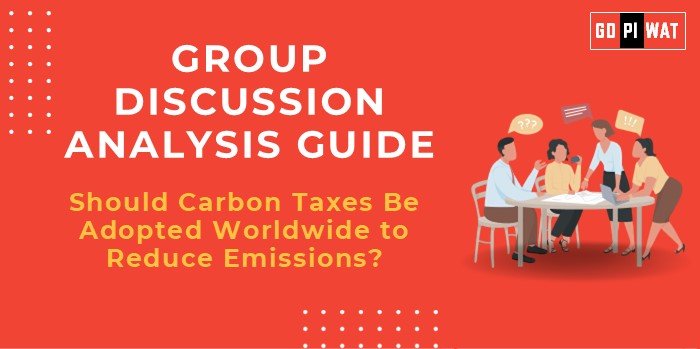🌍 Group Discussion Analysis Guide
🛢️ Topic: Should Carbon Taxes Be Adopted Worldwide to Reduce Emissions?
🔎 Introduction to Carbon Taxes
Opening Context: With global warming and climate change becoming critical issues, carbon taxes emerge as a promising economic mechanism to reduce emissions. They aim to hold emitters accountable, incentivizing a shift to greener practices.
Topic Background: First introduced in Finland in 1990, carbon taxes have since gained traction globally. The Paris Agreement of 2015 underscored their relevance, pushing nations to adopt policies reducing greenhouse gas emissions.
📉 Quick Facts and Key Statistics
- Global CO₂ Emissions: 36.8 billion tons (2022) – A stark reminder of the urgent need for emission control.
- Carbon Tax Implementation: 27 countries currently enforce carbon taxes, including Sweden, with the highest tax at $137/ton.
- Economic Impact: Sweden reduced emissions by 25% since adopting carbon taxes in 1991, while GDP grew by 78%.
- Global Carbon Pricing Gap: Only 23% of global emissions are priced, with an average of $6/ton—far below the $75/ton recommended by the IMF.
- Projected Benefits: Widespread carbon tax adoption could reduce global emissions by 32% by 2030 (World Bank).
👥 Stakeholders and Their Roles
- Governments: Implement policies and reinvest revenue in green infrastructure.
- Corporations: Adapt to green technologies or bear financial penalties.
- Citizens: Demand sustainable practices and bear potential cost increases.
- International Bodies: Advocate for uniform standards and monitor compliance (e.g., IPCC, IMF).
✅ Achievements and Challenges
Achievements:
- Economic Growth with Emission Reduction: Sweden’s dual success in economic expansion and emissions cuts.
- Incentive for Innovation: Companies like Tesla emerged in response to clean energy mandates.
- Global Awareness: Increased acceptance of sustainable practices.
Challenges:
- Economic Disparity: Developing nations may struggle with implementation due to limited resources.
- Carbon Leakage: High taxes may shift production to low-regulation areas.
- Public Resistance: Citizens often oppose increased costs (e.g., France’s Yellow Vests movement).
🌍 Global Comparisons:
- Success: Sweden, Norway, and Finland lead with high carbon taxes and emission reductions.
- Challenges: Developing nations lack infrastructure and face public backlash.
📖 Case Studies:
- Canada: Federal carbon pricing framework showcases a flexible approach.
- India: High reliance on coal makes implementation difficult but critical.
🗣 Structured Arguments for Discussion
Supporting Stance:
“Carbon taxes incentivize cleaner energy, fostering innovation and reducing global emissions effectively.”
Opposing Stance:
“Without international alignment, carbon taxes may lead to economic inequality and carbon leakage.”
Balanced Perspective:
“While carbon taxes are effective, global coordination and equitable frameworks are vital for success.”
💡 Effective Discussion Approaches
Opening Approaches:
- Use striking statistics: “Sweden reduced emissions by 25% since 1991 with carbon taxes—why can’t the world?”
- Highlight global urgency: “36.8 billion tons of CO₂ in 2022 calls for urgent action.”
Counter-Argument Handling:
- Economic concerns: Suggest revenue redistribution to vulnerable populations.
- Implementation barriers: Propose international collaboration for equitable frameworks.
🛠 Strategic Analysis of Strengths and Weaknesses
- Strengths: Proven success in emissions reduction, economic incentives for green innovation.
- Weaknesses: Public resistance, risk of economic disparity.
- Opportunities: Global collaboration, accelerated green tech adoption.
- Threats: Carbon leakage, uneven implementation globally.
🎓 Connecting with B-School Applications
- Real-World Applications: Projects on environmental economics, sustainable energy, and policy analysis.
- Sample Interview Questions:
- “What are the main barriers to global adoption of carbon taxes?”
- “How can carbon tax revenue be used to promote equity?”
- Insights for B-School Students:
- Research carbon pricing models.
- Explore global climate policies.
- Assess corporate ESG strategies.


